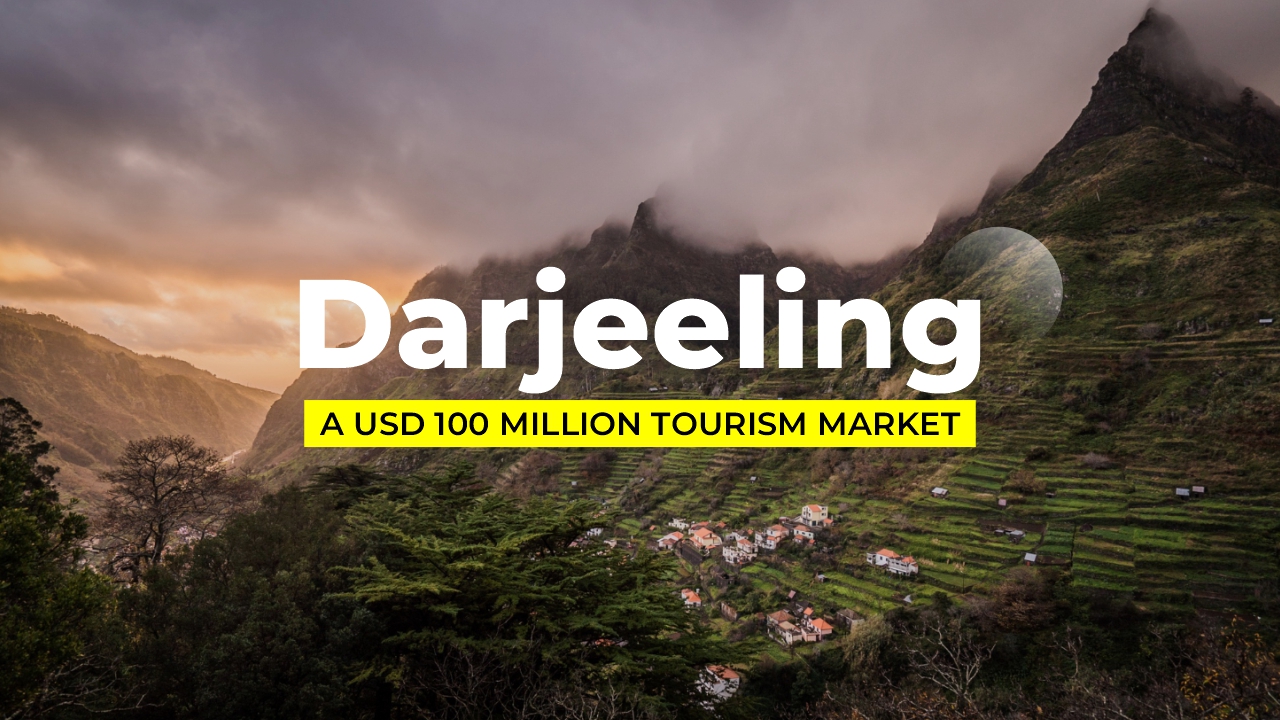-
Your trusted market research partner
- info@theindiawatch.com
- 8076704267

A USD 100 million tourism market, Darjeeling will continue to attract the hospitality business
Darjeeling is one of the most popular tourist destinations in the Indian state of West Bengal (WB). Before the lockdown, the hill station was receiving around 550,000- 600,000 tourists annually. The size of the Darjeeling tourism market is around USD 100 million, as per business research by The India Watch.
After the setback of the pandemic, like other hill stations, Darjeeling also suffered a slowdown in the tourist volume. However, now the market is recovering with tourist numbers picking up fast. Presently, around 350-400,000 tourists are visiting the Himalayan hill station.
The numbers are expected to rise further. One remarkable aspect of Darjeeling is its rising popularity amongst international tourists as 10% of the inflow comprises foreigners. Since the pre-independent era, Darjeeling has been a favorite summer haven for British officials. In 1835, the first time roads were built to connect the Himalayan hill stations to Kolkata. This was followed by building guest houses, resting bungalows, hospitals, and official accommodations. This was also a time, when rich landlords and aristocrats from Bengal and nearby states started preferring to own second homes in Darjeeling, thereby catapulting the Himalayan town into prominence.
Post-independence as well, Darjeeling continued to consolidate its position as a peripheral hill station in West Bengal. Although in the wake of the Indo-China war, foreign tourists were banned in Darjeeling. It resumed in 1985.
Current day Darjeeling is a major tourist attraction in West Bengal, east of India, and the Northeastern region. It is also called the gateway to the Northeast India. While a surge in tourist volume has resulted in the densification of certain parts of the Darjeeling hill station, most of it is still known for old-fashioned bungalows, pristine natural beauties, and quant-styled shops & cafes. The region is perfect for leisure tourism, rejuvenation & wellness, adventure sports, nature walks, rural tourism, etc.
One of the best times to visit Darjeeling is the summer months of (April- June) when the occupancy is mostly in the range of 90%. The summer months see high footfalls as Darjeeling offers a great escape from the heat of the plains. Another popular time of high tourist inflow is the October- November time when there are generally Navratri and Diwali breaks in West Bengal. This is also a time when a large number of foreigners visit the Darjeeling region due to climatic preferences.
Factors Driving Tourist Market in Darjeeling
- Darjeeling has plenty of activities for tourists from Himalayan toy trains, to sightseeing, to shopping to adventure sports such as hiking, rafting, rock climbing, etc.
- Darjeeling and its nearby regions such as Kurseong, Kalimpong, etc. are blessed with plenty of natural beauties such as scenic hills, spellbinding valleys, cascading rivers & waterfalls, popular vantage points, white orchid forests, etc.
- The hill station is also known for verdant tea gardens and quaint cafes. It is also close to the spectacular Himalayan peaks of Kanchenjunga and Everest. There are plenty of vantage points in and around Darjeeling from where the mighty Himalayas peaks can be enjoyed.
- The beautiful hill station is well connected to other popular tourist destinations such as Kalimpong, Shillong, Siliguri, etc. The Mahananda wildlife reserve is also located nearby.
- Darjeeling has been a popular hill station since the British time. The British civil servants, soldiers, and other aristocrats used to frequently visit Darjeeling, lured by its cold climate and scenic beauties. This has also resulted in the hill station being blessed with plenty of British-styled Bungalows, guest houses, official buildings, etc.
- Darjeeling is a beautiful amalgamation of numerous cultures such as North East Indian, Bengali, Tibetan, Bhutanese, and Nepali. Since ancient times, Darjeeling has been part of the trading route between North East India, West Bengal, Nepal, and Bhutan.
- Darjeeling is known for its commendable temperature throughout the year. During summer months the temp is between 15-20 degree Celsius. Likewise, during winter it goes down to 1 degree Celsius.
- Darjeeling also has popular temples and Buddhist monasteries, which makes it a place of religious and cultural significance. Likewise, it is well-known for famous schools, colleges, and youth festivals.
- The concept of weekend tourism is picking up in India which has seen numerous tourist destinations in the Sahyadri and Uttarakhand transforming into thriving markets. Darjeeling is also chronicling similar trends with a pick-up in weekenders from West Bengal, Northeast, Nepal, and certain parts of Bihar.
Investment scope in Darjeeling
The hospitality industry in Darjeeling is growing steadily, backed by a surge in tourist inflow and spending. In 2010, there were 280 active hotels in the Darjeeling district. Currently, there are 1350 hotels and resorts in Darjeeling, jumping by 382%.
As Darjeeling’s tourism industry continues to expand, there is tremendous opportunity in the region’s hospitality and hotel industry. While there is ample scope for 4-star and 5-star hotels, there is also plenty of headspace for alternate forms of tourism such as eco-resorts, nature cottages, spas & wellness centers, adventure sports companies, etc. Likewise, as the volume of tourists is increasing, there will be a rise in demand for shopping complexes, retails, cafes, restaurants, PBCLs, sporting arenas, taxi rental companies, etc.
With new investments emerging on the horizon, there will be a growing need for feasibility studies, market research studies, detailed project reports, market analyses, etc. for any such business query feel free to drop us a mail at info@theindiawatch.com

